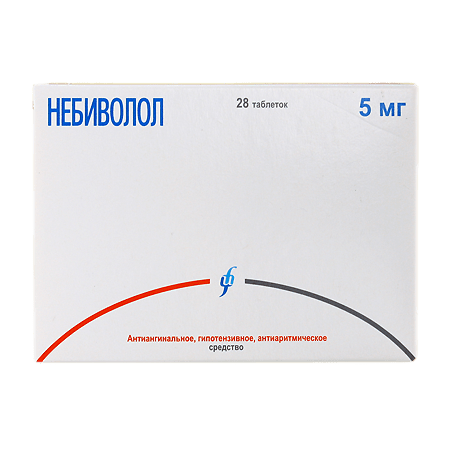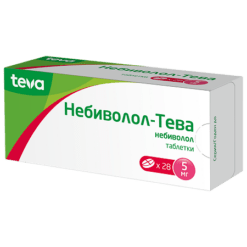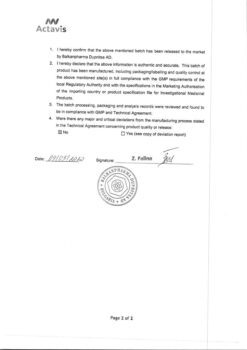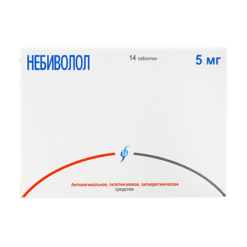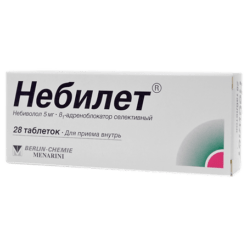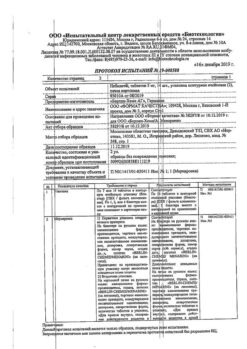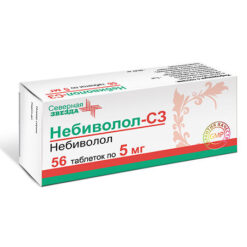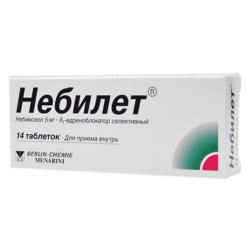No products in the cart.
Nebivolol, tablets 5 mg 28 pcs
€15.83 €13.19
Description
Pharmacotherapeutic group: β1-adrenoblocker selective.
Pharmacological properties
Pharmacodynamics
Nebivolol is a cardioselective β1-adrenoblocker, has antihypertensive, antianginal and antiarrhythmic effects. It reduces high blood pressure (BP) at rest, under physical stress and stress. Competitively and selectively blocks postsynaptic β1-adrenoreceptors, making them unavailable for catecholamines, modulates the release of endothelial vasodilatory factor nitric oxide (NO).
Nebivololol is a racemate of two enantiomers: SRRR-nebivolol (D-nebivolol) and RSSS-nebivolol (L-nebivolol), combining two pharmacological actions:
- D-nebivololol is a competitive and highly selective blocker
of β1-adrenoreceptors; - L-nebivolol has a mild vasodilatory effect by modulating the release of vasodilatory factor (NO) from the vascular endothelium.
The antihypertensive effect is also due to decrease of renin-angiotensin-aldosterone system (RAAS) activity (does not directly correlate with changes in plasma renin activity).
Hypotensive effect develops after ‑25 days of regular use of the drug. Sustained antihypertensive effect develops after 1-2 weeks of regular use of the drug, and in some cases – after 4 weeks, a stable effect is observed after ‑12 months.
With decreasing myocardial oxygen demand (heart rate (HR), decreasing ante- and post-load), nebivololol reduces the number and severity of angina attacks and increases exercise tolerance. Antiarrhythmic action is caused by the suppression of cardiac automatism (including in the pathological focus) and slowing of atrioventricular conduction.
Pharmacokinetics
absorption
After oral administration is rapidly absorbed from the gastrointestinal tract. Food intake has no effect on absorption, so nebivololol can be taken regardless of the time of meal. Bioavailability is approximately 12% in patients with “fast” metabolism (“primary passage” ‑effect) and may be almost complete in patients with “slow” metabolism.
Distribution
In plasma both enantiomers are predominantly bound to albumin.
The binding to plasma proteins for D-nebivololol is 98.1%, for
L-nebivolol is 97.9%.
Metabolism
Nebivololol is metabolized by alicyclic and aromatic hydroxylation and partial N-dealkylation. The resulting hydroxy- and amino derivatives conjugate with glucuronic acid and are excreted as
O- and N-glucuronides. The rate of metabolism of nebivolol by aromatic hydroxylation is genetically determined by oxidative polymorphism and depends on the CYP2D6 isoenzyme. The metabolic rate does not affect the efficacy of nebivolol.
Elimation
Extracted by the kidneys (38%) and through the intestine (48%). Half-life (T1/2) in patients with “fast” metabolism: hydroxymetabolites – 24 h, enantiomers of nebivololol – 10 h; in patients with “slow” metabolism: hydroxymetabolites –
48 h, enantiomers of nebivololol – 3050 ‑h. Excretion of unchanged nebivololol through the kidneys is less than 0.5% of the dose of the drug taken orally.
With regard to differences in metabolic rate, the dose of the drug should always be adjusted individually: patients with “slow” metabolism require a lower dose.
Indications
Indications
Arterial hypertension;
Coronary heart disease: prevention of angina attacks;
Chronic heart failure (as part of combination therapy).
Pharmacological effect
Pharmacological effect
Pharmacotherapeutic group: selective β1-adrenergic blocker.
Pharmacological properties
Pharmacodynamics
Nebivolol is a cardioselective β1-blocker and has antihypertensive, antianginal and antiarrhythmic effects. Reduces high blood pressure (BP) at rest, during physical exertion and stress. Competitively and selectively blocks postsynaptic β1-adrenergic receptors, making them inaccessible to catecholamines, modulates the release of endothelial vasodilating factor nitric oxide (NO).
Nebivolol is a racemate of two enantiomers: SRRR-nebivolol (D-nebivolol) and RSSS-nebivolol (L-nebivolol), combining two pharmacological actions:
D-nebivolol is a competitive and highly selective blocker
β1-adrenergic receptors;
L-nebivolol has a mild vasodilatory effect by modulating the release of vasodilating factor (NO) from the vascular endothelium.
The antihypertensive effect is also due to a decrease in the activity of the renin-angiotensin-aldosterone system (RAAS) (does not directly correlate with changes in plasma renin activity).
The hypotensive effect develops after 2-5 days of regular use of the drug. A stable antihypertensive effect develops after 1-2 weeks of regular use of the drug, and in some cases – after 4 weeks; a stable effect is observed after 1-2 months.
By reducing myocardial oxygen demand (decrease in heart rate (HR), decrease in preload and afterload), nebivolol reduces the number and severity of angina attacks and increases exercise tolerance. The antiarrhythmic effect is due to the suppression of cardiac automaticity (including in the pathological focus) and the slowing of atrioventricular conduction.
Pharmacokinetics
Suction
After oral administration, it is quickly absorbed from the gastrointestinal tract. Eating does not affect absorption, so nebivolol can be taken regardless of meal time. Bioavailability is about 12% in patients with “fast” metabolizers (first-pass effect) and can be almost complete in patients with “slow” metabolizers.
Distribution
In blood plasma, both enantiomers are predominantly associated with albumin.
Plasma protein binding for D-nebivolol is 98.1%, for
L-nebivolol – 97.9%.
Metabolism
Nebivolol is metabolized by alicyclic and aromatic hydroxylation and partial N-dealkylation. The resulting hydroxy and amino derivatives are conjugated with glucuronic acid and are excreted as
O- and N-glucuronides. The rate of metabolism of nebivolol by aromatic hydroxylation is genetically determined by oxidative polymorphism and depends on the CYP2D6 isoenzyme. Metabolic rate does not affect the effectiveness of nebivolol.
Removal
Excreted by the kidneys (38%) and through the intestines (48%). Half-life (T1/2) in patients with “fast” metabolism: hydroxymetabolites – 24 hours, nebivolol enantiomers – 10 hours; in patients with “slow” metabolism: hydroxymetabolites –
48 hours, enantiomers of nebivolol – 30-50 hours. Excretion of unchanged nebivolol through the kidneys is less than 0.5% of the dose of the drug taken orally.
Given differences in metabolic rates, the dose of the drug should always be selected individually: patients with a “slow” metabolism require a lower dose.
Special instructions
Special instructions
The withdrawal of β-blockers should be carried out gradually over 10 days (up to 2 weeks in patients with coronary heart disease).
Monitoring blood pressure and heart rate at the beginning of taking the drug should be daily.
In elderly patients, monitoring of kidney function is necessary (once every 4-5 months). For exertional angina, the dose of the drug should ensure resting heart rate within the limits
55-60 beats/min, with load – no more than 110 beats/min.
β-blockers can cause bradycardia: the dose should be reduced if the heart rate is less than 50-55 beats/min (see section “Contraindications”).
When deciding on the use of Nebivolol in patients with psoriasis, one should carefully weigh the expected benefits of using the drug and the possible risk of exacerbation of psoriasis.
Patients who use contact lenses should take into account that the use of beta-blockers may reduce the production of tear fluid.
When performing surgical interventions, the anesthesiologist should be warned that the patient is taking β-blockers.
Nebivolol does not affect plasma glucose concentrations in patients with diabetes mellitus. However, caution should be exercised when treating these patients because Nebivolol may mask certain symptoms of hypoglycemia (eg, tachycardia) caused by the use of oral hypoglycemic agents and insulin. Monitoring the concentration of glucose in the blood plasma should be carried out once every 4-5 months. (in patients with diabetes mellitus).
With hyperthyroidism, β-blockers can mask tachycardia.
β-blockers should be used with caution in patients with chronic obstructive pulmonary disease, as bronchospasm may increase.
β-blockers may increase sensitivity to allergens and the severity of anaphylactic reactions.
In smokers, the effectiveness of β-blockers is lower compared to non-smoking patients.
Impact on the ability to drive vehicles and other mechanisms
During the treatment period, care must be taken when driving vehicles and engaging in other potentially hazardous activities that require increased concentration and speed of psychomotor reactions.
Active ingredient
Active ingredient
Nebivolol
Composition
Composition
1 tablet contains:
Active substance:
Nebivolol hydrochloride – 5.45 mg (in terms of nebivolol – 5.00 mg).
Excipients:
Betadex – 23.00 mg;
Pregelatinized corn starch – 38.40 mg;
Microcrystalline cellulose – 108.55 mg;
Crospovidone – 1.90 mg;
Colloidal silicon dioxide – 0.90 mg;
Magnesium stearate – 1.80 mg.
Pregnancy
Pregnancy
Nebivolol may have harmful effects on pregnancy, the fetus and the newborn. Reduced placental perfusion by beta-blockers can cause fetal growth restriction, intrauterine fetal death, miscarriage and premature birth. Newborns may experience bradycardia, decreased blood pressure, hypoglycemia, and respiratory paralysis.
Use during pregnancy is possible only if the expected benefit to the mother outweighs the potential risk to the fetus. Nebivolol should be stopped 48-72 hours before delivery. In cases where this is not possible, it is necessary to ensure strict monitoring of newborns for 48-72 hours after birth.
Animal studies have shown that nebivolol is excreted in the milk of lactating animals. If it is necessary to use the drug during lactation, breastfeeding should be stopped.
Contraindications
Contraindications
Hypersensitivity to any of the components of the drug;
Acute heart failure;
Chronic heart failure in the stage of decompensation (requiring intravenous administration of drugs with inotropic effects);
Severe arterial hypotension (systolic blood pressure less than 90 mm Hg);
Sick sinus syndrome, including sinoauricular block;
Atrioventricular block II-III degree (without artificial pacemaker);
History of bronchospasm and bronchial asthma;
Pheochromocyme (without simultaneous use of a-blockers);
Metabolic acidosis;
Bradycardia (heart rate less than 50 beats/min);
Cardiogenic shock;
Severe liver dysfunction;
Severe peripheral circulatory disorders (“intermittent” claudication, Raynaud’s syndrome);
Myasthenia;
Depression;
Simultaneous use with floctafenine, sultopride (see section “Interaction with other drugs”);
Age up to 18 years (efficacy and safety have not been established).
With caution:
Side Effects
Side Effects
The frequency of side effects listed below was determined according to the World Health Organization classification – very often (more than 10%), often (more than 1% and less than 10%), infrequently (more than 0.1% and less than 1%), rarely (more than 0.01% and less than 0.1%), very rarely (less than 0.01%), frequency unknown (it is impossible to estimate the frequency of development based on available data).
From the immune system: frequency unknown – angioedema, hypersensitivity.
From the mental point of view: infrequently – “nightmare” dreams, depression; very rarely – hallucinations, psychosis, confusion.
From the nervous system: often – headache, dizziness, weakness, paresthesia; very rarely – fainting.
On the part of the organ of vision: frequency unknown – blurred vision, dry eyes.
From the gastrointestinal tract: often – nausea, constipation, diarrhea; infrequently – dyspepsia, flatulence, vomiting.
From the cardiovascular system: very often – bradycardia (in patients with CHF); often – worsening of CHF, first degree atrioventricular block, orthostatic hypotension; uncommon – bradycardia, heart failure, slowing of atrioventricular conduction/atrioventricular block, marked decrease in blood pressure, progression of concomitant “intermittent” claudication; very rarely – Raynaud’s syndrome.
From the skin and subcutaneous tissues: often – swelling; uncommon – erythematous skin rash, itching; very rarely – aggravation of psoriasis; frequency unknown – alopecia.
From the respiratory system: often – shortness of breath; infrequently – bronchospasm (including in the absence of a history of obstructive pulmonary diseases).
From the reproductive system: infrequently – erectile dysfunction.
General disorders: very often – dizziness (in patients with CHF); often – increased fatigue, swelling, intolerance to the drug; uncommon – photodermatosis, hyperhidrosis (in patients with CHF); very rarely – coldness/cyanosis of the extremities.
Interaction
Interaction
Pharmacodynamic interaction
When used simultaneously with blockers of “slow” calcium channels (SCBC) (verapamil, diltiazem), the negative effect on myocardial contractility and atrioventricular conduction increases. Intravenous administration of verapamil is not recommended during the use of nebivolol.
When nebivolol is used simultaneously with antihypertensive drugs, nitroglycerin, severe arterial hypotension may develop (special caution is required when used simultaneously with prazosin).
With the simultaneous use of nebivolol with centrally acting antihypertensive drugs (clonidine, guanfacine, moxonidine, methyldopa, rilmenidine), the course of heart failure may worsen due to a decrease in sympathetic tone (decreased heart rate and cardiac output, symptoms of vasodilation). In case of abrupt withdrawal of these drugs, especially before discontinuation of nebivolol, the development of “rebound” arterial hypertension (withdrawal syndrome) is possible.
Concomitant use of nebivolol and dihydropyridine BMCCs (amlodipine, felodipine, licidipine, nifedipine, nicardipine, nimodipine, nitrendipine) may increase the risk of arterial hypotension. An increased risk of further deterioration of ventricular pumping function in patients with heart failure cannot be excluded.
When used simultaneously with class I antiarrhythmic drugs (quinidine, flecainide, disopyramide, mixelitine) and amiodarone, the negative inotropic effect may be enhanced and the time of excitation through the atria may be prolonged.
When used simultaneously with cardiac glycosides, there was no increase in the effect on slowing down atrioventricular conduction.
The simultaneous use of nebivolol and drugs for general anesthesia may suppress reflex tachycardia and increase the risk of developing arterial hypotension.
No clinically significant interaction with non-steroidal anti-inflammatory drugs has been established.
Acetylsalicylic acid as an antiplatelet agent can be used simultaneously with nebivolol.
Concomitant use of nebivolol with tricyclic antidepressants, barbiturates and phenothiazine derivatives may enhance the antihypertensive effect of nebivolol.
The simultaneous use of nebivolol with insulin and oral hypoglycemic agents may mask some symptoms of hypoglycemia (rapid heartbeat, tachycardia).
Concomitant use with floctafenine is contraindicated: nebivolol can interfere with compensatory reactions of the cardiovascular system associated with arterial hypotension or shock, which can be caused by floctafenine.
Concomitant use of nebivolol with baclofen and amifostine leads to increased arterial hypotension.
When used simultaneously with sultopride, there is an increased risk of ventricular arrhythmia of the “pirouette” type.
When used concomitantly, sympathomimetic agents inhibit the activity of nebivolol.
Pharmacokinetic interaction
With simultaneous use of nebivolol with drugs that inhibit serotonin reuptake, or with other drugs that are biotransformed with the participation of the CYP2D6 isoenzyme, the concentration of nebivolol in the blood plasma increases, the metabolism of nebivolol slows down, which can lead to the risk of bradycardia.
When used concomitantly with digoxin, nebivolol does not affect the pharmacokinetic parameters of digoxin.
When used simultaneously with cimetidine, the concentration of nebivolol in the blood plasma increases (there are no data on the effect on the pharmacological effects of the drug).
The simultaneous use of nebivolol and ranitidine does not affect the pharmacological parameters of nebivolol.
With simultaneous use of nebivolol with nicardipine, the concentration of active substances in the blood plasma increases slightly, but this does not have clinical significance.
Concomitant use of nebivolol and ethanol, furosemide or hydrochlorothiazide does not affect the pharmacokinetics of nebivolol.
No clinically significant interaction between nebivolol and warfarin has been established.
Overdose
Overdose
Symptoms: marked decrease in blood pressure, nausea, vomiting, cyanosis, bradycardia, atrioventricular block, acute heart failure, bronchospasm, loss of consciousness, cardiogenic shock, coma, cardiac arrest, hypoglycemia, convulsions.
Treatment: gastric lavage, taking activated carbon. In case of a pronounced decrease in blood pressure, it is necessary to place the patient in a horizontal position with elevated legs, and, if necessary, administer intravenous fluids and vasopressors.
For bradycardia, 0.5-2 mg of atropine should be administered intravenously; if there is no positive effect, a transvenous or intracardiac pacemaker may be installed.
In case of atrioventricular block (II-III stage), intravenous administration of β-adrenergic agonists is recommended; if they are ineffective, the issue of installing an artificial pacemaker should be considered.
In case of heart failure, treatment begins with the administration of cardiac glycosides and diuretics; if there is no effect, it is advisable to administer dopamine, dobutamine or vasodilators.
For bronchospasm, IV β2-adrenergic agonists are used.
For ventricular extrasystole, lidocaine can be prescribed (class IA antiarrhythmic drugs are not used).
For convulsions, intravenous diazepam is recommended. For hypoglycemia, intravenous administration of dextrose (glucose) is indicated.
Manufacturer
Manufacturer
Izvarino Pharma, Russia
Additional information
| Manufacturer | Izvarino Pharma, Russia |
|---|---|
| Medication form | pills |
| Brand | Izvarino Pharma |
Other forms…
Related products
Buy Nebivolol, tablets 5 mg 28 pcs with delivery to USA, UK, Europe and over 120 other countries.

